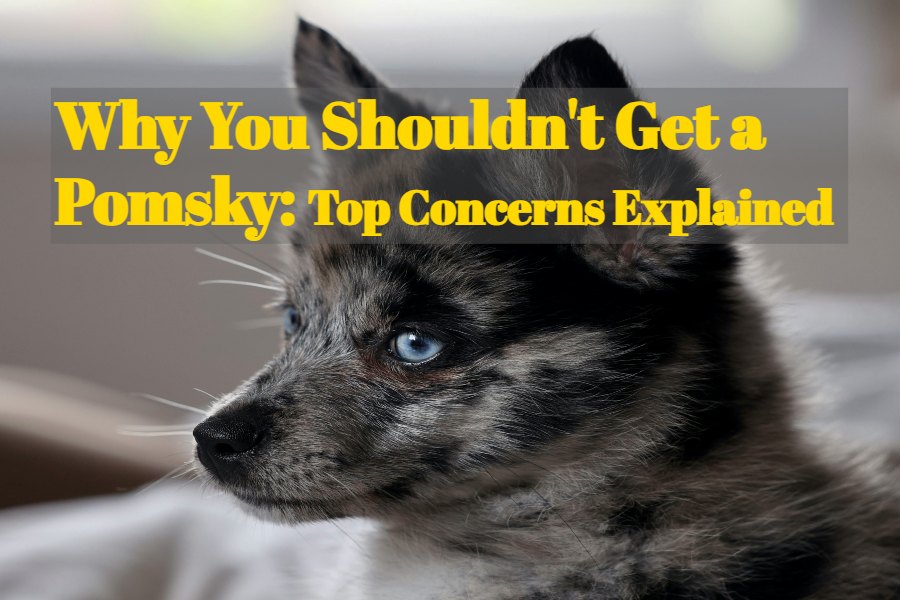A Pomsky may not be the ideal pet due to their high energy and demanding exercise needs. These hybrid dogs also require significant grooming and can be costly.
Pomskies, a mix between Pomeranians and Siberian Huskies, are known for their striking appearance and playful nature. Despite their allure, they come with a set of challenges that potential pet owners should consider. With an exuberant personality, these dogs need extensive daily exercise to stay mentally and physically healthy, which might not suit those with a busy lifestyle.
The Pomsky’s thick coat needs constant care to prevent matting and shedding, adding to the upkeep. Their popularity also makes them quite an investment, with prices for one often reaching a premium. Before being swayed by their charming looks, it’s crucial to assess if your lifestyle aligns with the needs of a Pomsky.

Credit: www.reddit.com
Misconceptions About Pomsky Temperament
The Pomsky, a cross between a Pomeranian and a Husky, often carries a host of misconceptions, especially regarding its temperament. While they can certainly win hearts with their charming looks, there’s more beneath the surface that prospective owners should consider.
The Husky Influence
Pomskies inherit traits from both Pomeranians and Huskies. Their Husky ancestry may lead many to believe these dogs are always friendly and calm. Yet, Husky characteristics can actually result in high energy levels and a strong-willed nature, demanding experienced handling.
Often, their need for regular exercise and mental stimulation is underestimated. Failing to meet these needs can lead to destructive behavior. Owners must be prepared to invest time and patience in training and exercise, adjusting their lifestyle to their dog’s needs.
Unpredictable Behavior
Expect a mix of personality traits in Pomskies, leading to unpredictable behavior. It’s a roll of the genetic dice; some exhibit more Pomeranian-like traits, while others lean towards their Husky heritage. This can complicate training and behavior prediction.
For instance, they might show a surprising predatory drive towards smaller animals or sudden bursts of energy, regardless of their small size. Even with proper training, potential owners should be ready for a lifelong commitment to managing such behaviors.
Pomskies’ cute appearance often masks the reality of their complex needs. Understanding these factors is crucial before deciding to welcome a Pomsky into your home. The reality of their energetic and unpredictable nature may not be suited to everyone’s lifestyle, especially those looking for a low-maintenance companion.
Health Issues In Pomskies
Creating a Pomsky combines Husky and Pomeranian traits. This mix can lead to health concerns. Getting to know these health issues is crucial before choosing a Pomsky.
Genetic Health Problems
Pomskies inherit genes from two breeds. This mix sometimes causes genetic issues. Common ones include:
- Eye disorders: such as cataracts or glaucoma.
- Luxating patella: where kneecaps slip out of place.
- Heart conditions: inherited from both parent breeds.
Talk with a vet about these risks. A vet can offer advice on genetic testing.
Long-term Care Needs
Pomskies often need long-term care that can get expensive. Issues such as dental problems or hip dysplasia can arise. They’ll likely need:
| Long-Term Care | Details |
|---|---|
| Regular check-ups | Preventive care can spot issues early. |
| Special diet | Some need a diet for their sensitive stomachs. |
| Exercise routine | A balance to manage their energy and health. |
Set up a care plan with your vet. Be ready for long-term commitments.
Challenges In Training
Training a Pomsky can be a tough hill to climb. These adorable pups, a mix between a Pomeranian and a Siberian Husky, are notorious for their stubbornness when it comes to training. Let’s explore just what makes teaching them such a formidable task.
Strong-willed Nature
Pomskies inherit a willful disposition from both parent breeds. This headstrong attitude means they often choose to do things their own way. It’s not that they can’t learn; it’s about finding the right techniques to guide them.
Consistency And Patience Required
When it comes to training a Pomsky, consistency is key. Be prepared for days of repetition and minimal progress. Here’s what you will need:
- Consistent Commands: Use the same words for commands every time.
- Regular Training Sessions: Practice makes perfect, don’t skip sessions.
- Positive Reinforcement: Reward good behavior to encourage repetition.
Not forgetting, a hefty dose of patience is vital. They might test your limits, but keep cool for the best results.

Credit: www.reddit.com
Exercise And Space Requirements
Before bringing a Pomsky (a mix of Pomeranian and Husky) into your life, it is vital to consider their exercise and space needs. These adorable canines are known for their stunning looks and playful nature, but they come with a set of demands that not every pet owner can meet.
High Energy Levels
Pomskies inherit the high energy of their Husky ancestors. They require regular exercise to stay healthy and happy.
- Long walks daily are a must.
- They love to run and play.
- Park visits help burn off their excess energy.
Not Suitable For Small Living Spaces
These dogs are not the best fit for small apartments or homes without yards. Pomskies thrive when they have space to explore and play.
- A spacious backyard is ideal.
- Without enough space, a Pomsky may become bored and destructive.
- Indoor space should also be sufficient for them to move around comfortably.
Cost Of Ownership
The ‘Cost of Ownership’ encompasses much more than the initial price of your furry friend. It’s essential to consider both the upfront cost and the ongoing financial commitments involved in raising a Pomsky. These energetic companions may carry a hefty price tag, and their maintenance isn’t light on the wallet either.
Initial Price Tag
Pomskies, a blend between Pomeranians and Huskies, often come with a substantial initial cost. This price reflects their status as a trendy designer breed. Let’s break down the numbers:
- Cost of a Pomsky puppy: $1,000 to $5,000
- Factors influencing price:
- Breeder reputation
- Pedigree
- Coat color and pattern
- Eye color
The allure of unique attributes such as blue eyes or a specific fur pattern can drive the cost even higher. Before falling for a puppy’s charm, ensure you are ready for the financial commitment.
Ongoing Expenses
Pomskies don’t stop costing money after you bring them home. They have ongoing expenses just like any other pet. These include:
| Expense Category | Annual Cost Estimate |
|---|---|
| Veterinary Care | $200 – $700 |
| Food | $250 – $700 |
| Grooming | $30 – $500 |
| Training and Socialization | $50 – $300 |
| Accessories and Supplies | $100 – $500 |
| Emergency medical expenses | Variable |
Moreover, Pomskies can be prone to certain health issues due to their mixed breed nature, which might result in unforeseen veterinary bills.
Remember to factor in regular expenses like toys, beds, and leashes. Frequent grooming needs, due to their often thick fur, can add up quickly too. Lastly, do not forget about potential training costs, as this hybrid can inherit the stubbornness of a Husky.
Ethical Breeding Concerns
Ethical breeding concerns are crucial when considering adding a new furry friend to your family. The adorable Pomsky, a crossbreed between a Pomeranian and a Siberian Husky, may capture hearts with its charming looks. Yet, potential owners must understand the underlying issues related to their breeding practices. In the pursuit of creating the perfect miniature Husky lookalike, ethical boundaries often get blurred.
Pomsky Popularity and Backyard BreedersPomsky Popularity And Backyard Breeders
The Pomsky’s rapid rise in popularity brings risks. High demand drives backyard breeders to produce these pups without concern for health or welfare. These breeders often lack proper knowledge or disregard the genetic complications of such crossbreeding. This can lead to puppies with unpredictable behavior and health issues that burden owners with high veterinary costs and emotional stress.
The Importance of Supporting Responsible BreedingThe Importance Of Supporting Responsible Breeding
Choosing responsibly bred pets is vital. Reputable breeders conduct health screenings and genetic testing. They ensure breeding practices aim for strong, healthy puppies. Supporting ethical breeding means fewer animals suffer. It also encourages the betterment of breed standards and contributes to the health of future generations.

Credit: www.reddit.com
Frequently Asked Questions Of Why You Shouldn’t Get A Pomsky
What Is A Pomsky’s Typical Temperament?
Pomskies can exhibit a mix of traits from Pomeranians and Huskies. They are often energetic, intelligent, and may show a stubborn streak, which can pose a challenge for less experienced dog owners. Their temperament may not suit every household.
Are Pomskies High-maintenance Pets?
Yes, Pomskies are considered high-maintenance. They require regular grooming due to their thick fur and have high energy levels that demand daily exercise. Additionally, they may need attentive training and socialization to manage their stubbornness and intelligence.
How Much Does Owning A Pomsky Cost?
Owning a Pomsky can be quite expensive. Initial costs for a Pomsky puppy can be high, and ongoing expenses include food, grooming, veterinary care, and potential obedience classes. These costs can add up over time, making them a significant financial commitment.
Can Pomskies Adapt To Apartment Living?
Pomskies may struggle with apartment living due to their high energy levels and need for regular exercise. Without ample space or frequent outdoor activity, they may become restless and exhibit undesirable behaviors. Proper training and mental stimulation are crucial.
Conclusion
Opting for a Pomsky requires considering several factors. Their high energy, grooming needs, and potential health issues are pivotal points. Before a commitment, evaluate lifestyle compatibility and long-term care. Seek breeds that align better with your life for pet harmony and joy.
Wise choices ensure a happier home for both pet and owner alike.

